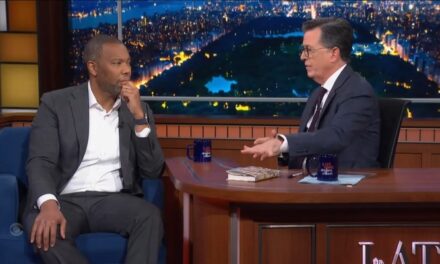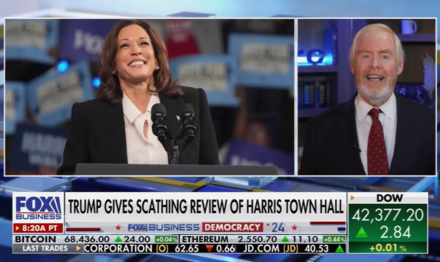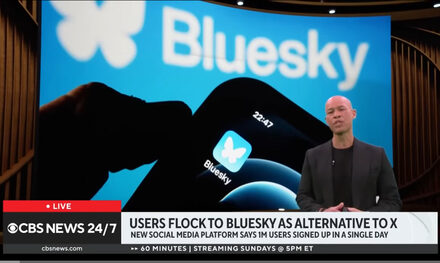We support our Publishers and Content Creators. You can view this story on their website by CLICKING HERE.

As the election approaches, look for the Regime Media to embed propaganda in subtler pieces than what you normally see at the top of their newscasts, such as their unhinged campaign trail recaps. Case in point: this “Eye on America” item from CBS, touting “nuance” at the border that is anything but nuanced.
Watch as Norah O’Donnell and Omar Villafranca introduce their border dispatch:
NORAH O’DONNELL: A CBS news poll shows 58% of likely voters consider the U.S.-Mexico border a major factor in their choice for president. Well, there are no shortage of opinions in the immigration debate, we wanted to see what those closest to the issue are thinking. So for tonight’s Eye on America, CBS’s Omar Villafranca hits the road for a 1,000 mile-plus reality check.
OMAR VILLAFRANCA: The southern border as described on the campaign trail…
DONALD TRUMP: It’s an invasion of our country.
KAMALA HARRIS: I saw the violence and chaos.
VILLAFRANCA: …or seen on the news…
CAMILO MONTOYA: In just the past 24 hours, more than 10,000 migrants have been processed…
VILLAFRANCA: …can easily create a picture of all border towns as lawless and chaotic. But the reality is more nuanced, as we learned during our 1600-mile trip from McAllen, Texas, to the California coast.
Villafranca goes on to assure viewers that the southern border is not 2,000 miles of badlands, and that is certainly a legitimate take. In order to accomplish this, he interviews various local business owners and public officials. Villafranca also points to the various industrial concerns.
But none of this mitigates the fact that tens of millions of illegal migrants poured into the United States over the last three and a half years. In fact, you hear no allusion to a migrant crisis anywhere in the report except for the Trump soundbite where he says “invasion.”
That is, until it is time to put forth a solution for the border crisis, at which point Villafranca champions the failed Senate deal that would’ve put millions of illegal migrants on a fast track to citizenship.
VILLAFRANCA: Arizona borders Mexico for more than 350 miles, and it is a drug smuggling hotspot. In FY 2024, 66% of the fentanyl seized on the U.S.-Mexico border happened in the Tucson sector, which includes all the ports of entry in Arizona, including the one behind me. Douglas, Arizona, mayor Donald Huish liked the bipartisan border bill that’s been front and center in the campaign. The one that died after Donald Trump’s criticism.
KAMALA HARRIS: I will bring it back up and probably sign it into law.
DONALD HUISH: It would help us because we would’ve had more Border Patrol agents. I can understand why people didn’t like the entire bill, but why stop talking about it?
VILLAFRANCA: Did that frustrate you?
HUISH: It frustrated the heck out of us.
In the end, this supposedly nuanced report is little more than Regime propaganda, 11 days from a presidential election.
Exit question: Did you know that there are 150,000 migrants jammed up in southern Mexico until after the election, after which they will march north? Because the Regime Media are making sure that you don’t know.
Click “expand” to view the full transcript of the aforementioned report as aired on the CBS Evening News on Thursday, October 24th, 2024:
CBS EVENING NEWS
10/24/24
6:50 PM
NORAH O’DONNELL: A CBS news poll shows 58% of likely voters consider the U.S.-Mexico border a major factor in their choice for president. Well, there are no shortage of opinions in the immigration debate, we wanted to see what those closest to the issue are thinking. So for tonight’s Eye on America, CBS’s Omar Villafranca hits the road for a 1,000 mile-plus reality check.
OMAR VILLAFRANCA: The southern border as described on the campaign trail…
DONALD TRUMP: It’s an invasion of our country.
KAMALA HARRIS: I saw the violence and chaos.
VILLAFRANCA: …or seen on the news…
CAMILO MONTOYA: In just the past 24 hours, more than 10,000 migrants have been processed…
VILLAFRANCA: …can easily create a picture of all border towns as lawless and chaotic. But the reality is more nuanced, as we learned during our 6000-mile trip from McAllen, Texas, to the California coast. In Laredo, Texas, ranked as one of the safest cities in the state, mayor Victor Trevino told us his city is not the Wild West he often sees depicted.
VICTOR TREVINO: There’s cartels, there’s crime, and this and that — which is not true.
VILLAFRANCA: He points to a different surge. $320 billion worth of GM and Tesla car parts, microchips, and produce that cross America’s busiest port of entry by train and truck. About 500 miles west, in Presidio, Texas, restaurant owner Hector Armendariz sees people leaving for better paying jobs, including his own family.
HECTOR ARMENDARIZ: This is my teenager. Daughter. She’s graduating this May. We have three. They left. And they don’t come back. All our kids leave, and they don’t come back.
VILLAFRANCA: Mayor John Ferguson says the local economy relies on hundreds of Mexican citizens who illegally cross every day to work in restaurants or oilfields. What would happen if it was harder for Mexican residents to come over to work in Presidio?
JOHN FERGUSON: I think we’d be in serious trouble like, you know, the pandemic, where you didn’t have enough workers and things would slow down, and certain sectors might kind of dry up.
VILLAFRANCA: Columbus, New Mexico mayor Phil Skinner says without border trade towns shrink, with consequences you may not think about. How many dentists are in town here?
PHIL SKINNER: In Columbus?
VILLAFRANCA: Yeah.
SKINNER: None.
VILLAFRANCA: How many dentists are in Puerto palomas?
SKINNER: Ten.
VILLAFRANCA: So if you need dental work, you’re going to Mexico.
SKINNER: Yes.
VILLAFRANCA: Arizona borders Mexico for more than 350 miles, and it is a drug smuggling hotspot. In FY 2024, 66% of the fentanyl seized on the U.S.-Mexico border happened in the Tucson sector, which includes all the ports of entry in Arizona, including the one behind me. Douglas, Arizona, mayor Donald Huish liked the bipartisan border bill that’s been front and center in the campaign. The one that died after Donald Trump’s criticism.
KAMALA HARRIS: I will bring it back up and probably sign it into law.
DONALD HUISH: It would help us because we would’ve had more Border Patrol agents. I can understand why people didn’t like the entire bill, but why stop talking about it?
VILLAFRANCA: Did that frustrate you?
HUISH: It frustrated the heck out of us.
VILLAFRANCA: Frustration is everywhere along the border. Just ask Sheriff Mark Dannels in Arizona’s Cochise County, which struggles with the influx of drug mules and human smugglers.
Are you optimistic or pessimistic about what’s going to happen here in the future?
MARK DANNELS: It’s more of an unknown because politics in the country is so divided right now.
VILLAFRANCA: Which is why the one thing you won’t find on the border is hope for a solution. For Eye on America, I’m Omar Villafranca, along the U.S.-Mexico border.

 Conservative
Conservative  Search
Search Trending
Trending Current News
Current News 





